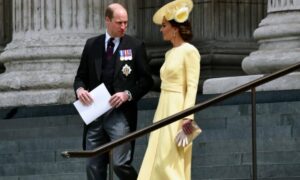The British monarchy, steeped in centuries of tradition, is navigating a delicate balance between heritage and modernity. Prince William and Kate Middleton, the Prince and Princess of Wales, are crafting a thoughtful plan to guide their daughter, Princess Charlotte, through her role as the “spare” to her brother, Prince George, the heir to the throne. At 10 years old, Charlotte holds the third position in the line of succession, a role historically fraught with challenges, as vividly illustrated by Prince Harry’s public reflections. The couple’s approach focuses on fostering Charlotte’s emotional well-being and individuality, aiming to shield her from the pressures that defined Harry’s experience as the “number two.”
Charlotte’s upbringing reflects a broader effort to adapt the royal family to contemporary values. Born in 2015, she has already made history as the first princess to retain her place in the succession line regardless of gender, thanks to a 2013 law reform. The strategy devised by William and Kate emphasizes not only her royal duties but also her personal growth. Their goal is to ensure Charlotte thrives in a role that, while prestigious, often carries a sense of being overshadowed.
- Mental health focus: The couple prioritizes Charlotte’s emotional resilience, drawing from their own mental health advocacy.
- Balanced education: Charlotte attends the same school as her siblings, promoting equality and normalcy.
- Limited public exposure: Her appearances at royal events are carefully curated to protect her childhood.
- Family support system: Close ties with her Middleton grandparents provide a grounding influence.
The initiative draws lessons from the past. Harry, who occupied the “spare” role for years, detailed in his 2023 memoir “Spare” the emotional toll of living in William’s shadow, describing feelings of isolation and undervaluation within the royal framework.
Succession reforms
Princess Charlotte benefits from a landmark change in royal protocol. The Succession to the Crown Act of 2013 abolished male primogeniture, ensuring that the firstborn, regardless of gender, maintains precedence in the line of succession. Enacted for those born after October 2011, the law secured Charlotte’s position as third in line when she was born in 2015, unaffected by the birth of her younger brother, Louis. The reform also lifted historical restrictions, such as disqualification for marrying Catholics, aligning the monarchy with modern sensibilities.
Prior to this change, female royals were often surpassed by younger male siblings. Charlotte’s secure position marks a significant shift, positioning her as a symbol of gender equality within the institution. The monarchy, under scrutiny for its traditionalist roots, showcases Charlotte’s role as evidence of its evolving structure.
The reform’s implications extend beyond Charlotte’s place in line. It reflects a broader societal push for equality, a value championed by Queen Elizabeth II, who reigned for 70 years until her passing in 2022. Her support for the 2013 act underscored the need to modernize the Crown’s framework.
- End of male primogeniture: The 2013 law ensures gender does not dictate succession order.
- Secured position: Charlotte remains third in line, unaffected by future siblings.
- Monarchy’s modernization: The reform addresses calls for equality within a historic institution.
Learning from history
The strategy for Charlotte is deeply informed by Prince Harry’s experiences. In his memoir, released in January 2023, Harry described the burdens of being the “spare,” likening his role to a constant shadow cast by William, the heir. He recounted feelings of rivalry, exclusion, and being perceived as a contingency plan within the royal family. These revelations sparked widespread discussion about the psychological challenges of royal roles.
Harry’s candid accounts, amplified through interviews and a Netflix series, highlighted the emotional complexities of his position. He spoke of strained relations with William and a sense of being sidelined during official engagements. William and Kate, aware of these struggles, are determined to prevent Charlotte from facing similar challenges. Their approach emphasizes nurturing her individuality and ensuring she feels valued beyond her place in the succession.
Relations between Harry and the royal family remain strained. As of May 2025, reports indicate limited contact between King Charles III and his younger son, who relocated to the United States in 2020. Harry’s public disclosures have widened the rift, while William focuses on his duties as heir and father, maintaining a private stance on family matters.
Education as a foundation
Education forms a cornerstone of Charlotte’s preparation. She attends Lambrook School in Berkshire, a private institution where she studies alongside George and Louis. The choice reflects William and Kate’s commitment to providing their children with a semblance of normalcy, away from the royal spotlight. Lambrook’s nurturing environment offers a range of activities, from sports to arts, allowing Charlotte to explore diverse interests.
William and Kate, who met at the University of St. Andrews, view education as a pathway to independence. They encourage Charlotte to pursue passions such as music, theater, and sports, including tennis, which she plays regularly. Her education also incorporates gradual lessons about public responsibility, tailored to her age to avoid overwhelming her.
Charlotte’s public appearances are strategically limited. In 2024, she joined Kate at Wimbledon, where her mother serves as patron of the All England Club. These moments introduce Charlotte to her future role while preserving her childhood.
- Shared school experience: Attending Lambrook with her siblings fosters equality.
- Extracurricular engagement: Charlotte participates in sports, arts, and music.
- Gradual public role: Her event appearances are selective and supervised.
- Independence focus: Education aims to empower Charlotte for future choices.
Middleton family influence
Charlotte’s maternal grandparents, Carole and Michael Middleton, play a vital role in her upbringing. Residing in Bucklebury, about an hour from London, the Middletons provide a haven where Charlotte, George, and Louis can enjoy a more ordinary lifestyle. Family visits often involve gardening, cooking, and outdoor play, offering a contrast to the formality of Kensington Palace.
Carole Middleton, known for her organizational skills, hosts family gatherings that strengthen bonds among the grandchildren. Her influence provides Charlotte with a support network outside the royal sphere, which William and Kate deem essential for her emotional stability. The Middletons’ grounded approach complements the couple’s parenting philosophy.
Kate, raised in a middle-class family, instills values of simplicity and diligence in her children. During visits to Bucklebury, Charlotte engages in everyday tasks, such as helping in the kitchen or caring for pets, reinforcing a sense of normalcy.
Mental health priority
Mental health is a central focus for William and Kate. Through their Heads Together campaign, launched in 2016, they advocate for psychological well-being, a principle that shapes their parenting. For Charlotte, this means an environment where she can openly express emotions, with access to professional support if needed.
The royal family, once criticized for emotional restraint, is undergoing a cultural shift. William, who lost his mother, Princess Diana, at 15, is particularly attuned to the importance of emotional support. He and Kate engage their children in age-appropriate conversations about feelings, fostering openness. Charlotte, described as confident and expressive, thrives in this supportive setting.
This approach aligns with broader societal trends. In the UK, mental health awareness has surged over the past decade, with increased funding for psychological services and public campaigns. William and Kate leverage their platform to normalize these discussions, reflecting their personal and public commitments.
- Heads Together initiative: The couple’s campaign promotes mental health awareness.
- Open communication: Charlotte is encouraged to discuss her emotions.
- Professional resources: The family has access to mental health specialists.
- Societal alignment: Their focus mirrors growing UK acceptance of mental health dialogue.
Controlled public exposure
Charlotte’s public appearances are meticulously managed. Unlike past generations, when royals faced early media scrutiny, William and Kate prioritize privacy. Charlotte participates in high-profile events, such as Queen Elizabeth II’s Platinum Jubilee in 2022, but her engagements are limited to those reinforcing family unity or institutional values.
In 2024, she joined Kate at a London charity event, interacting with children supported by a royal-backed organization. The experience was designed to introduce Charlotte to public service without excessive pressure. William, vocal about protecting his children from media intrusion, enforces strict boundaries with the press.
The British media, notorious for its relentless coverage of the royals, faces increasing restrictions. William and Kate have set clear guidelines, limiting unauthorized photos and speculative stories. This protection is crucial for Charlotte, who could otherwise face undue comparisons with her siblings.
Elizabeth II’s legacy
Queen Elizabeth II, who died in 2022 at 96, profoundly influences Charlotte’s upbringing. The monarch, who reigned for seven decades, balanced duty and family with remarkable skill. She understood the challenges of the “spare” role, having witnessed her sister, Princess Margaret, struggle with it. Elizabeth reportedly advised William on preparing his children for their roles while addressing their personal needs.
Charlotte, seven at the time of her great-grandmother’s death, holds fond memories of Elizabeth. Kate shared in 2022 that Charlotte was moved to tears during the queen’s funeral, reflecting their emotional bond. Elizabeth’s legacy guides William and Kate as they blend duty with modern parenting values.
Under King Charles III, the monarchy faces pressure to remain relevant. Charlotte’s upbringing, emphasizing equality and well-being, positions her as a bridge between tradition and innovation.
- Elizabeth’s influence: The queen’s balanced approach shapes William and Kate’s strategy.
- Emotional connection: Charlotte cherished her time with her great-grandmother.
- Future readiness: The monarchy adapts to maintain relevance for the next generation.
Sibling dynamics
The relationship among Charlotte, George, and Louis is a key element of William and Kate’s plan. Raised together at Lambrook and in shared family activities, the siblings are encouraged to collaborate rather than compete. George, as the future king, receives tailored guidance, but Charlotte and Louis are equally valued for their unique contributions.
Charlotte, often protective of Louis, acts as a mediator among the siblings. During Elizabeth II’s funeral, she guided her younger brother, then four, with notable maturity. Her bond with George is marked by shared interests, including sports and music, fostering camaraderie.
William and Kate promote joint activities, such as family camping trips and charity projects, to strengthen sibling ties. This approach aims to prevent the rivalries that strained William and Harry’s relationship in their youth and beyond.
Long-term vision
Preparing Charlotte for her royal role is a long-term endeavor. William and Kate, aware that she may take on significant public duties in adulthood, approach her development with care. At 10 years old in May 2025, Charlotte has years of childhood ahead, yet she already shows interest in causes like environmental conservation, a priority for her father.
The monarchy, under constant scrutiny, relies on its next generation to sustain its legitimacy. Charlotte, with her historic position and modern upbringing, embodies a blend of tradition and progress. William and Kate’s focus on her well-being underscores their belief that the Crown’s strength lies in its people.

The British monarchy, steeped in centuries of tradition, is navigating a delicate balance between heritage and modernity. Prince William and Kate Middleton, the Prince and Princess of Wales, are crafting a thoughtful plan to guide their daughter, Princess Charlotte, through her role as the “spare” to her brother, Prince George, the heir to the throne. At 10 years old, Charlotte holds the third position in the line of succession, a role historically fraught with challenges, as vividly illustrated by Prince Harry’s public reflections. The couple’s approach focuses on fostering Charlotte’s emotional well-being and individuality, aiming to shield her from the pressures that defined Harry’s experience as the “number two.”
Charlotte’s upbringing reflects a broader effort to adapt the royal family to contemporary values. Born in 2015, she has already made history as the first princess to retain her place in the succession line regardless of gender, thanks to a 2013 law reform. The strategy devised by William and Kate emphasizes not only her royal duties but also her personal growth. Their goal is to ensure Charlotte thrives in a role that, while prestigious, often carries a sense of being overshadowed.
- Mental health focus: The couple prioritizes Charlotte’s emotional resilience, drawing from their own mental health advocacy.
- Balanced education: Charlotte attends the same school as her siblings, promoting equality and normalcy.
- Limited public exposure: Her appearances at royal events are carefully curated to protect her childhood.
- Family support system: Close ties with her Middleton grandparents provide a grounding influence.
The initiative draws lessons from the past. Harry, who occupied the “spare” role for years, detailed in his 2023 memoir “Spare” the emotional toll of living in William’s shadow, describing feelings of isolation and undervaluation within the royal framework.
Succession reforms
Princess Charlotte benefits from a landmark change in royal protocol. The Succession to the Crown Act of 2013 abolished male primogeniture, ensuring that the firstborn, regardless of gender, maintains precedence in the line of succession. Enacted for those born after October 2011, the law secured Charlotte’s position as third in line when she was born in 2015, unaffected by the birth of her younger brother, Louis. The reform also lifted historical restrictions, such as disqualification for marrying Catholics, aligning the monarchy with modern sensibilities.
Prior to this change, female royals were often surpassed by younger male siblings. Charlotte’s secure position marks a significant shift, positioning her as a symbol of gender equality within the institution. The monarchy, under scrutiny for its traditionalist roots, showcases Charlotte’s role as evidence of its evolving structure.
The reform’s implications extend beyond Charlotte’s place in line. It reflects a broader societal push for equality, a value championed by Queen Elizabeth II, who reigned for 70 years until her passing in 2022. Her support for the 2013 act underscored the need to modernize the Crown’s framework.
- End of male primogeniture: The 2013 law ensures gender does not dictate succession order.
- Secured position: Charlotte remains third in line, unaffected by future siblings.
- Monarchy’s modernization: The reform addresses calls for equality within a historic institution.
Learning from history
The strategy for Charlotte is deeply informed by Prince Harry’s experiences. In his memoir, released in January 2023, Harry described the burdens of being the “spare,” likening his role to a constant shadow cast by William, the heir. He recounted feelings of rivalry, exclusion, and being perceived as a contingency plan within the royal family. These revelations sparked widespread discussion about the psychological challenges of royal roles.
Harry’s candid accounts, amplified through interviews and a Netflix series, highlighted the emotional complexities of his position. He spoke of strained relations with William and a sense of being sidelined during official engagements. William and Kate, aware of these struggles, are determined to prevent Charlotte from facing similar challenges. Their approach emphasizes nurturing her individuality and ensuring she feels valued beyond her place in the succession.
Relations between Harry and the royal family remain strained. As of May 2025, reports indicate limited contact between King Charles III and his younger son, who relocated to the United States in 2020. Harry’s public disclosures have widened the rift, while William focuses on his duties as heir and father, maintaining a private stance on family matters.
Education as a foundation
Education forms a cornerstone of Charlotte’s preparation. She attends Lambrook School in Berkshire, a private institution where she studies alongside George and Louis. The choice reflects William and Kate’s commitment to providing their children with a semblance of normalcy, away from the royal spotlight. Lambrook’s nurturing environment offers a range of activities, from sports to arts, allowing Charlotte to explore diverse interests.
William and Kate, who met at the University of St. Andrews, view education as a pathway to independence. They encourage Charlotte to pursue passions such as music, theater, and sports, including tennis, which she plays regularly. Her education also incorporates gradual lessons about public responsibility, tailored to her age to avoid overwhelming her.
Charlotte’s public appearances are strategically limited. In 2024, she joined Kate at Wimbledon, where her mother serves as patron of the All England Club. These moments introduce Charlotte to her future role while preserving her childhood.
- Shared school experience: Attending Lambrook with her siblings fosters equality.
- Extracurricular engagement: Charlotte participates in sports, arts, and music.
- Gradual public role: Her event appearances are selective and supervised.
- Independence focus: Education aims to empower Charlotte for future choices.
Middleton family influence
Charlotte’s maternal grandparents, Carole and Michael Middleton, play a vital role in her upbringing. Residing in Bucklebury, about an hour from London, the Middletons provide a haven where Charlotte, George, and Louis can enjoy a more ordinary lifestyle. Family visits often involve gardening, cooking, and outdoor play, offering a contrast to the formality of Kensington Palace.
Carole Middleton, known for her organizational skills, hosts family gatherings that strengthen bonds among the grandchildren. Her influence provides Charlotte with a support network outside the royal sphere, which William and Kate deem essential for her emotional stability. The Middletons’ grounded approach complements the couple’s parenting philosophy.
Kate, raised in a middle-class family, instills values of simplicity and diligence in her children. During visits to Bucklebury, Charlotte engages in everyday tasks, such as helping in the kitchen or caring for pets, reinforcing a sense of normalcy.
Mental health priority
Mental health is a central focus for William and Kate. Through their Heads Together campaign, launched in 2016, they advocate for psychological well-being, a principle that shapes their parenting. For Charlotte, this means an environment where she can openly express emotions, with access to professional support if needed.
The royal family, once criticized for emotional restraint, is undergoing a cultural shift. William, who lost his mother, Princess Diana, at 15, is particularly attuned to the importance of emotional support. He and Kate engage their children in age-appropriate conversations about feelings, fostering openness. Charlotte, described as confident and expressive, thrives in this supportive setting.
This approach aligns with broader societal trends. In the UK, mental health awareness has surged over the past decade, with increased funding for psychological services and public campaigns. William and Kate leverage their platform to normalize these discussions, reflecting their personal and public commitments.
- Heads Together initiative: The couple’s campaign promotes mental health awareness.
- Open communication: Charlotte is encouraged to discuss her emotions.
- Professional resources: The family has access to mental health specialists.
- Societal alignment: Their focus mirrors growing UK acceptance of mental health dialogue.
Controlled public exposure
Charlotte’s public appearances are meticulously managed. Unlike past generations, when royals faced early media scrutiny, William and Kate prioritize privacy. Charlotte participates in high-profile events, such as Queen Elizabeth II’s Platinum Jubilee in 2022, but her engagements are limited to those reinforcing family unity or institutional values.
In 2024, she joined Kate at a London charity event, interacting with children supported by a royal-backed organization. The experience was designed to introduce Charlotte to public service without excessive pressure. William, vocal about protecting his children from media intrusion, enforces strict boundaries with the press.
The British media, notorious for its relentless coverage of the royals, faces increasing restrictions. William and Kate have set clear guidelines, limiting unauthorized photos and speculative stories. This protection is crucial for Charlotte, who could otherwise face undue comparisons with her siblings.
Elizabeth II’s legacy
Queen Elizabeth II, who died in 2022 at 96, profoundly influences Charlotte’s upbringing. The monarch, who reigned for seven decades, balanced duty and family with remarkable skill. She understood the challenges of the “spare” role, having witnessed her sister, Princess Margaret, struggle with it. Elizabeth reportedly advised William on preparing his children for their roles while addressing their personal needs.
Charlotte, seven at the time of her great-grandmother’s death, holds fond memories of Elizabeth. Kate shared in 2022 that Charlotte was moved to tears during the queen’s funeral, reflecting their emotional bond. Elizabeth’s legacy guides William and Kate as they blend duty with modern parenting values.
Under King Charles III, the monarchy faces pressure to remain relevant. Charlotte’s upbringing, emphasizing equality and well-being, positions her as a bridge between tradition and innovation.
- Elizabeth’s influence: The queen’s balanced approach shapes William and Kate’s strategy.
- Emotional connection: Charlotte cherished her time with her great-grandmother.
- Future readiness: The monarchy adapts to maintain relevance for the next generation.
Sibling dynamics
The relationship among Charlotte, George, and Louis is a key element of William and Kate’s plan. Raised together at Lambrook and in shared family activities, the siblings are encouraged to collaborate rather than compete. George, as the future king, receives tailored guidance, but Charlotte and Louis are equally valued for their unique contributions.
Charlotte, often protective of Louis, acts as a mediator among the siblings. During Elizabeth II’s funeral, she guided her younger brother, then four, with notable maturity. Her bond with George is marked by shared interests, including sports and music, fostering camaraderie.
William and Kate promote joint activities, such as family camping trips and charity projects, to strengthen sibling ties. This approach aims to prevent the rivalries that strained William and Harry’s relationship in their youth and beyond.
Long-term vision
Preparing Charlotte for her royal role is a long-term endeavor. William and Kate, aware that she may take on significant public duties in adulthood, approach her development with care. At 10 years old in May 2025, Charlotte has years of childhood ahead, yet she already shows interest in causes like environmental conservation, a priority for her father.
The monarchy, under constant scrutiny, relies on its next generation to sustain its legitimacy. Charlotte, with her historic position and modern upbringing, embodies a blend of tradition and progress. William and Kate’s focus on her well-being underscores their belief that the Crown’s strength lies in its people.







